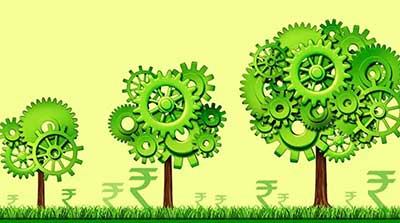Relevance: GS-3: Indian Economy and issues relating to planning, mobilization, of resources, growth; Conservation, environmental pollution and degradation, environmental impact assessment
Relevance: GS-2: Government policies and interventions for development in various sectors
Key Phrases: Net Zero economy, crisil report, NDCs, renewable energy development, low carbon economic model, Production-Linked Incentive (PLI), environmental, social and governance (ESG) aspects, Revamped Distribution Sector Scheme, desulphurization and smart metering
Context:
- Recently, a crisil report highlighted that the Corporate capital expenditure (capex) in India is poised for a leap in a new direction—green investments.
- For the first time, priorities of a green transition are sweeping the Indian economy. A change in capex composition is already evident.
- Industrial capex, which comprised only a fourth of overall annual average capex of about ₹12 trillion in the past five fiscal years, is estimated to have grown at a pace of over 30% in 2021-22.
- Similarly, Infrastructure capex, in the past five fiscal years, is estimated to have grown at a pace of over 24%.
What are key observations highlighted in the Editorial regarding change in capital expenditure market towards a greener economy?
- Post pandemic companies preferring more low carbon economic model:
- Unlike infrastructure capex, which is dominated by the central and state governments, industrial capex has over 60% of it accounted for by the private sector.
- Post-pandemic investment planning has seen large players in sectors such as cement and steel undertaking Capex in low carbon economy.
- Production-Linked Incentive (PLI) scheme that we see as a major
driver of industrial capex:
- Around ₹4 trillion investment annually is expected over the next three years.
- Out of the total PLI capex plans, nearly 55% is green. This trend is visible across many industrial segments—either for ecosystem development or for better efficiency.
- Green capex has begun to soar:
- Crisil’s analysis across infrastructure and industrial segments indicates that nearly 10% of the total capex through fiscal 2025-26 could be green and may rise to over 20% by 2030.
- Climate change and calamities such as the pandemic have catalysed how businesses have started factoring in environmental, social and governance (ESG) aspects.
- Bold targets of climate commitments at COP-26 preferred
decarbonisation of economy:
- Targets include 500GW of non-fossil fuel capacity, 50% generation from renewable sources, a 1-billion tonne reduction in emissions, and a drop in emission intensity through various efficiency drives, all of it aimed at achieving carbon neutrality by 2070.
- India’s power and transport segments are the early green investors, since they account for the lion’s share of India's Emissions.
- Crisil expects about ₹22-24 trillion to be spent on decarbonization through 2030, of which a big chunk will be in these two fields.
- Renewable energy alone would account for 65% of total green investment, increasing its share in total power capacity to 49% from 25% today.
- Government initiatives further fuelling green economy:
- Centre-led schemes such as the Revamped Distribution Sector Scheme could halve aggregate technical and commercial losses from their current high of 23-24% through government influenced investment plans.
- Areas such as flue gas desulphurization and smart metering will see spends of ₹2 trillion.
- The captive plants which make up at least 10-12% of India’s power production, companies in sectors like cement and steel are set to invest heavily in technologies such as waste heat recovery and green hydrogen.
- Major push for green transportation:
- In transportation, most emissions happen on roads, so efforts will focus on electric vehicles (EVs), batteries and their components.
- The government is investing in multiple technologies:
- Ethanol blending and compressed natural gas penetration
- Faster shift to EVs is expected post 2025.
- Hydrogen-linked commercial-carriage transport systems will see huge investments in the next few years.
- Large corporations geared for change:
- Large Indian businesses are serious about reducing their carbon footprint.
- An analysis of the top 100 listed industrial companies shows that some 60% of them make greenhouse gas disclosures, at least half have some form of climate action initiated, and a quarter have set net-zero deadlines, mostly earlier than India’s 2070 target.
- The capex commitments of companies that have made green capex announcements total ₹14 trillion. Large players may account for about 75% of green investments until 2030.
- Supportive financial profiles:
- Sound financial profiles are a prerequisite for a sustained investment cycle, and India Inc appears to be well placed on this score as well.
- Crisil assessed over 740 companies from about 40 sectors, and found that their balance sheet is very sustainably financed and less stressed.
- Along with improving cash balances and rising profits, nearly two-thirds of these companies showed a drop in net debt.
Way Forward:
- Given the large size of the domestic market there remain vast opportunities to be tapped for Green investment.
- An implementable policy framework for both national and state levels is needed for streamlining the investment process.
- Developing a better information management system in India may help in information asymmetry , borrowing costs and lead to efficient resource allocation in this economy.
- While the government will have to play its role through relevant policies, the main onus lies on various regulators like RBI, SEBI etc which can help in mobilisation of financial resources for companies as well as for clean energy investors.
Source: The Hindu BL
Mains Question:
Q. What do you mean by De-carbonisation of GDP? Discuss how can this concept help in resolving the dilemma of achieving rapid economic growth and reducing environmental footprint.( 10 marks).








